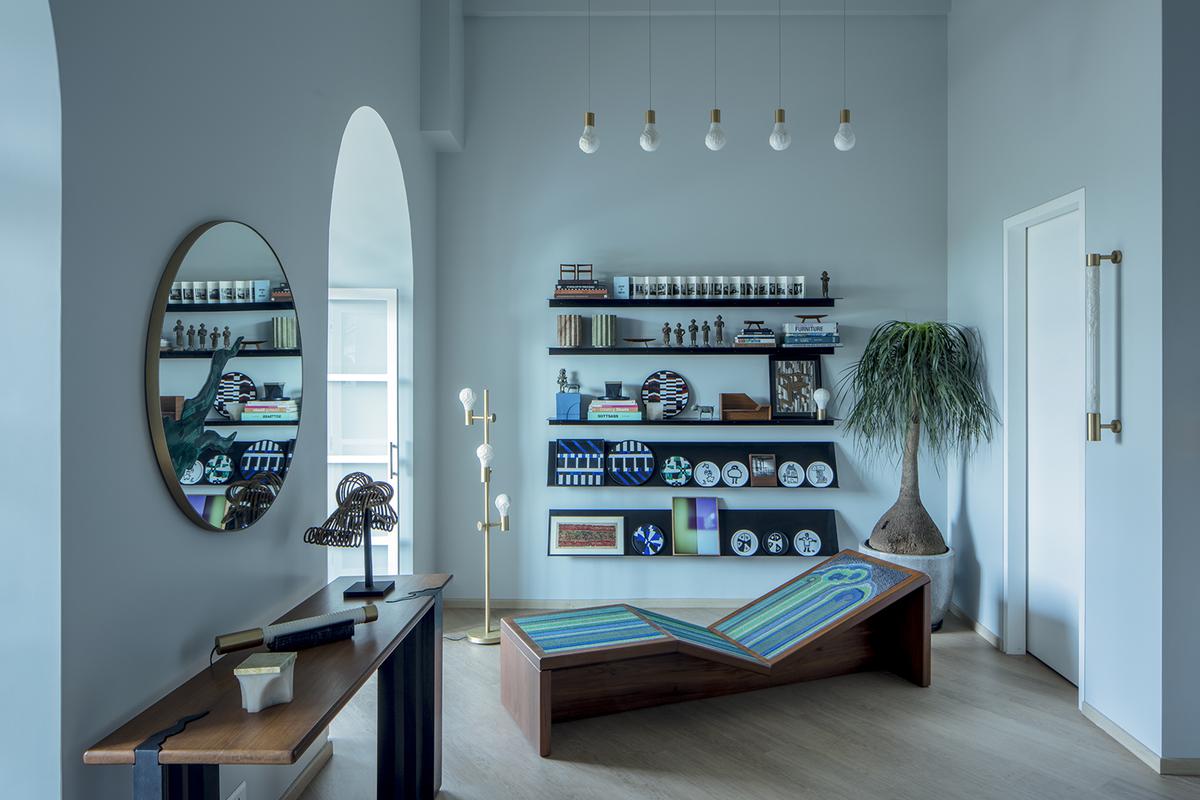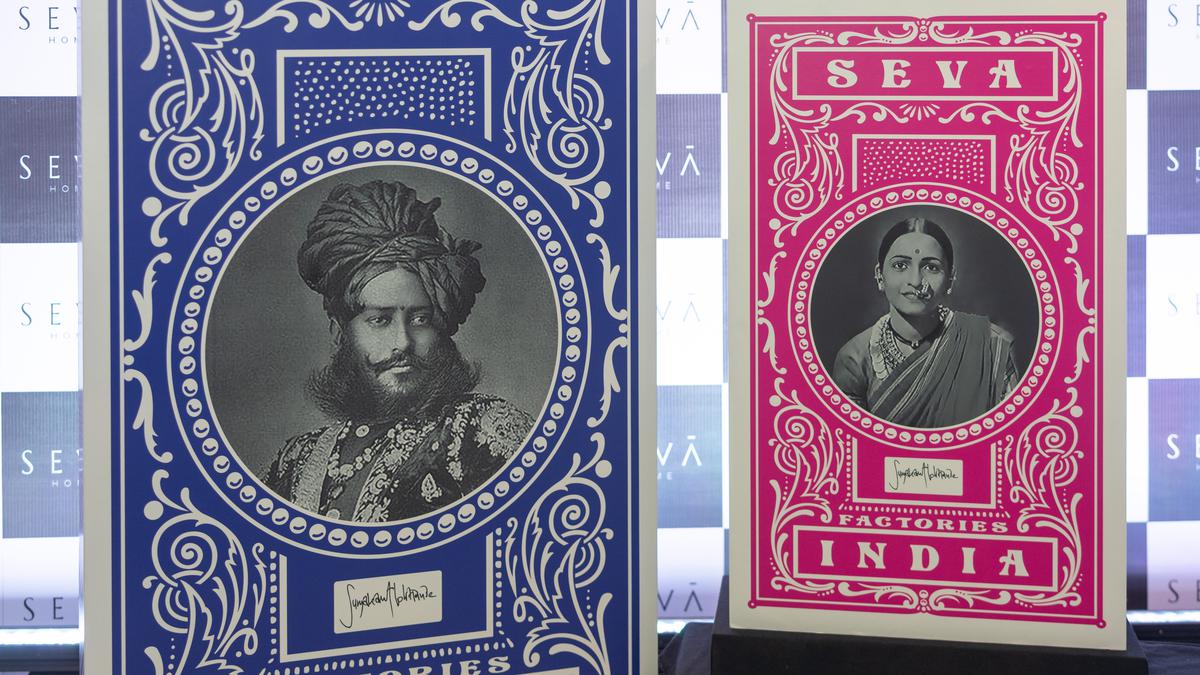With fluted marble vases, Channapatna lights and shibori consoles, interior designers are increasingly making traditional Indian craft their focal point
With fluted marble vases, Channapatna lights and shibori consoles, interior designers are increasingly making traditional Indian craft their focal point
When Ashiesh Shah set out to make ‘The Channapatna Light’ in 2020, a take on the indigenious toy-craft of Karnataka, little did he know it would be his toughest project till date. “A functional light fitting made in collaboration with Noor Salma, a master craftswoman, boundaries of scale were one of the first speedbumps we faced through the development of this fixture,” says the designer, adding that it was especially challenging to make the light modular for ease in assembly on site. Each module had to be carefully measured to ensure that it could make room for the beads, all whilst not damaging the wiring running within. In terms of installation, the modules along with the wires had to be lifted and anchored to the ceiling taking the orientation and curvature into consideration, he explains.
The Channapatna Light
| Photo Credit: Special Arrangement
The custom fixture (upwards of ₹5 lakh), that is now homed in Sequel BKC, a restaurant in Mumbai, is a classic example of how interior designers are increasingly honouring India’s diverse craft in their projects. No longer are traditional craft forms elements of mere tokenism — a rug or a framed weave — but are now a mainstay in decor briefs. “There has been a definite shift in the perception of luxury,” says Ashiesh, adding how he sees people gravitating towards objects and techniques that are “indigenous, honouring artisanship infused with a contemporary flair”. “People are looking at design through a local lens, to value and celebrate the maker, the locale and the processes involved.”
Take for instance Mangrove Collective’s indigo shibori console with brass legs and an oakwood body. “Shibori artists use thread to isolate many small, repeated points on the fabric which makes it an intricate and detailed process,” says founder and design principal Suman Sharma, who believes with a combination of artistry and practicality along with the sense of timelessness, “there is a leaning towards furniture which integrates craftsmanship and technology, to interpret age-old techniques that have lasted the test of time”.
Be it traditional marble inlay work by artisans in Agra, Uttarakhand’s pine needle weaving, or handcrafted bamboo, we take a look at how Indian craft is finding place in everything from furniture, lighting fixtures and ornamental decor.
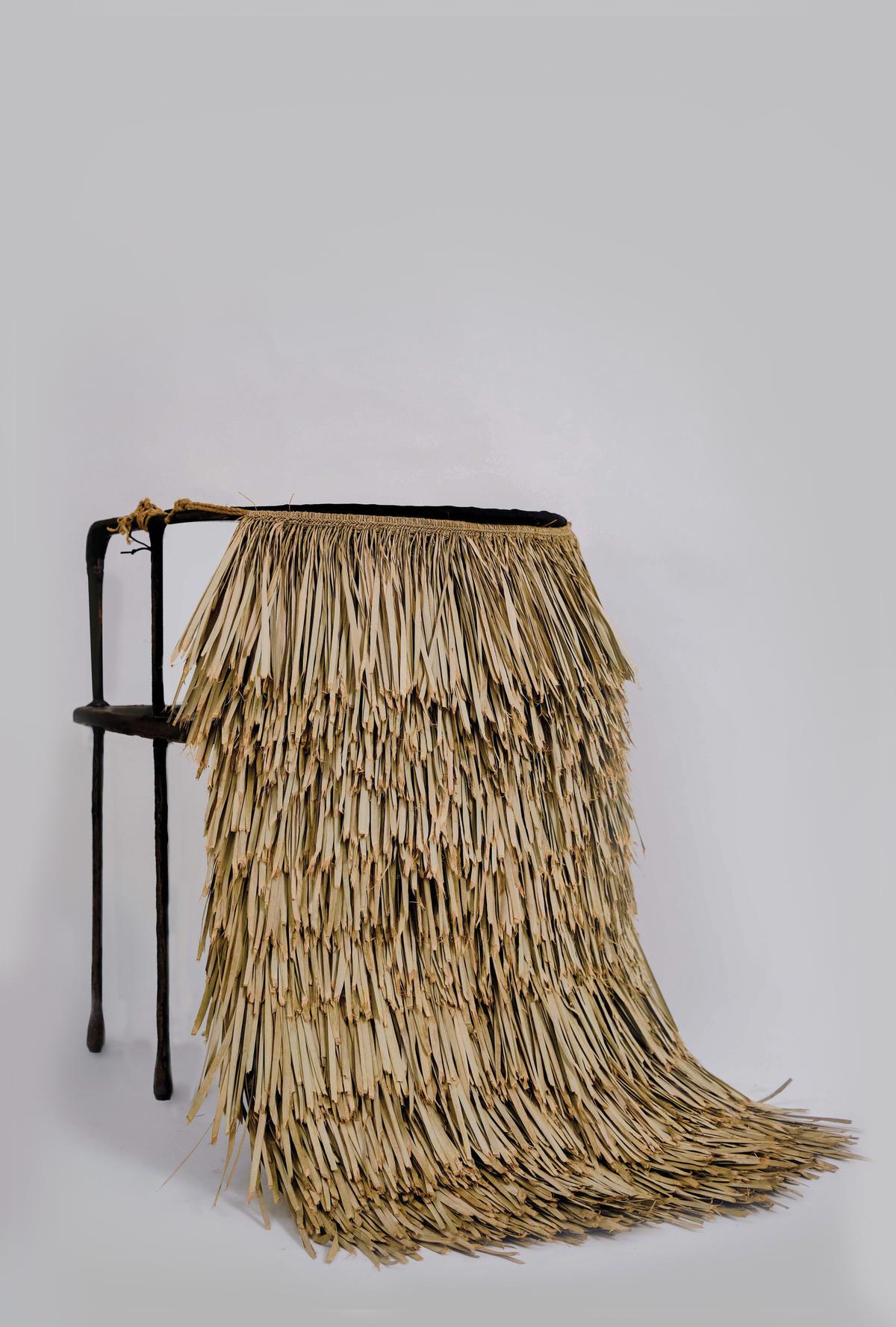
The Naga Chair
| Photo Credit: Special Arrangement
Naga weaving @ Asheish Shah, Mumbai
Designer Ashiesh Shah’s Naga Chair (upwards of ₹1.5 lakh) — cast in aluminium and finished in a dark bronze — draws inspiration from the form of French-American artist Louise Bourgeois’s ‘Maman’ sculpture. “Standing on five legs that appear unstable, much like its parent inspiration, the body of the chair is cast in three parts and has every piece that fits uniquely illustrating its handmade, tactile quality. The stature of the traditional raincoat was the perfect accompaniment to the fragile metal frame,” says Ashiesh, the first Indian designer to debut on luxury e-commerce site, The Invisible Collection, earlier this year.
This protective raincoat, he says, is traditionally used as a body cloak and made with a wild palm, commonly referred to as ‘elephant grass’, intricately woven by the tribes in Nagaland using the macramé process employing a hand-woven knotting technique into squares, leaving the ends as they are. “The form of the chair allows one to appreciate the hand-woven piece from inside and out as it trails along the chair and is visually an extension of the body once sat on, an addition of visual balance,” says Ashiesh, explaining that his designers work alongside master craftsmen from all over the country. “Interestingly, certain sketches developed several years ago are realised into design objects based on the craft deemed fit for its form and function,” says the designer who is now working on a new collection inspired by the theory of Photokinetism with design objects integrating light, colour and movement.
Other favourites from the atelier that draw from Indian craft include the Kantlo Console, designed in terracotta and cast aluminium that can be used as perch stools, tables; the bird lamp featuring Dokra and Naga weaving; and dhokra stools that are Ashiesh’s first exploration of the Chhattisgarh craft.
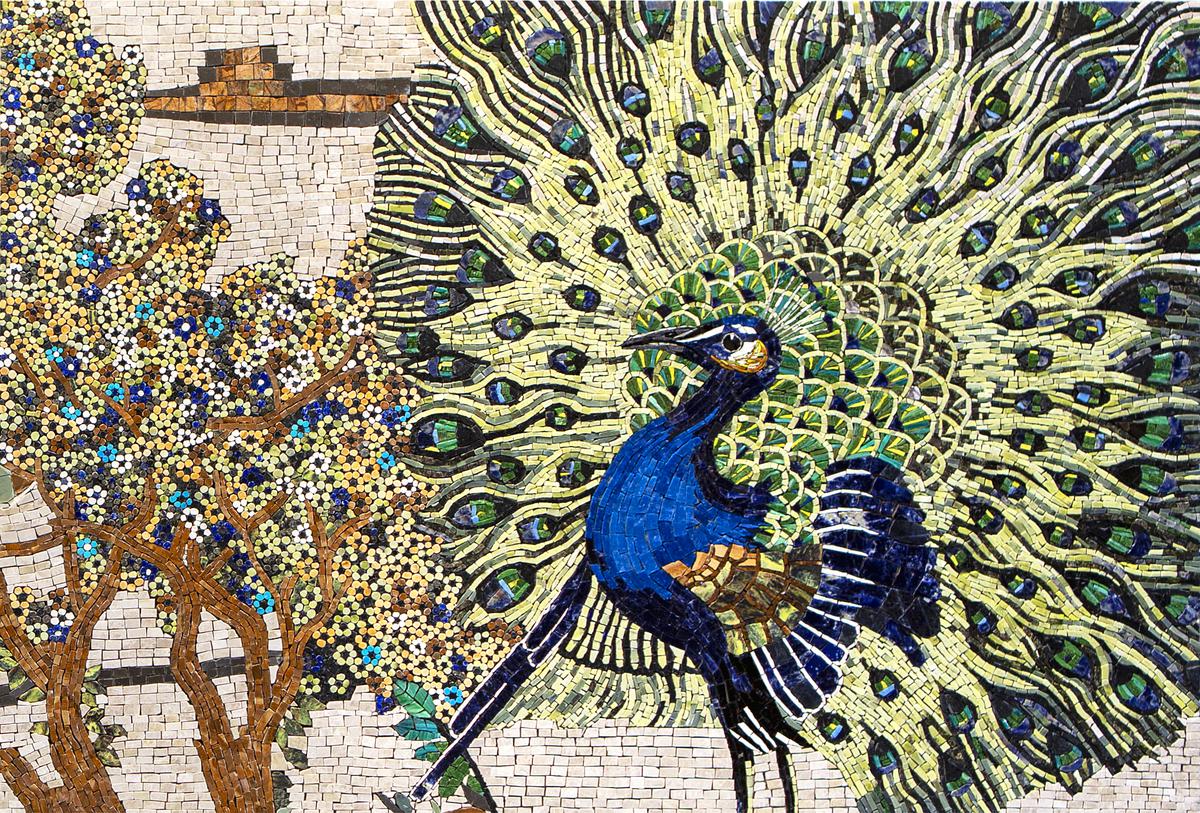
From the Tesserae collection
| Photo Credit: Sanjeev Agrawal
Glass mosaic @ Orvi Home, Jaipur
Handcrafted using centuries-old shattered glass mosaic technique, the brand’s latest table (₹12,600) draws from European mosaic art. Launched recently under the Tesserae collection, the pattern has been carefully laid out by craftsmen in the organic form of an areca palm leaf, which is a symbol of peace and triumph, explains Sanjeev Agarwal, CEO and founder. “Crafting this collection of tables was rather challenging since it requires a keen eye for detail and a high precision hand to be able to cut tiny pieces of stone and glass with a hand-held hammer,” he says, adding that each collection and product is meticulously made by the artisans.
Other contemporary designs with Indian craft include their wall decor with stone and brass inlay (₹4,650), handmade using centuries-old pietra dura/ parchinkari technique. “White marble is embellished with decorative inlays of semi-precious materials,” says Sanjeev, who is glad that the post-lockdown survival of Indian craft has led to handmade being preferred over machine-made art. Coming up are two collections highlighting the stone carving and fluting on stones from ancient India.

From Rooshad Shroff’s collection
| Photo Credit: Neville Sukhia
Marble inlay and wood embroidery @ Rooshad Shroff, Mumbai
The marble inlay work at Rooshad’s studio is the “culmination of a decade’s association with artisans of Agra and their relentless efforts to perfect and push the boundaries of their art”. The plates from the 2019 Gyaan Collection are hand-cut using traditional techniques and are then inlaid with semi-precious stones to create contemporary compositions. “We are soon launching a series on curved surfaces, which has been particularly challenging and involved years of R&D before getting it off the ground,” explains the designer who is currently focussed on marble carving, marble inlay and embroidery on wood. “The latter is a pioneering method of replacing traditional upholstery on furniture with zardozi. Studio offerings currently comprise fluted marble vases, carved marble lights and a whole range of embroidered furniture, among other things, and a line of marble accessories is in the pipeline.”
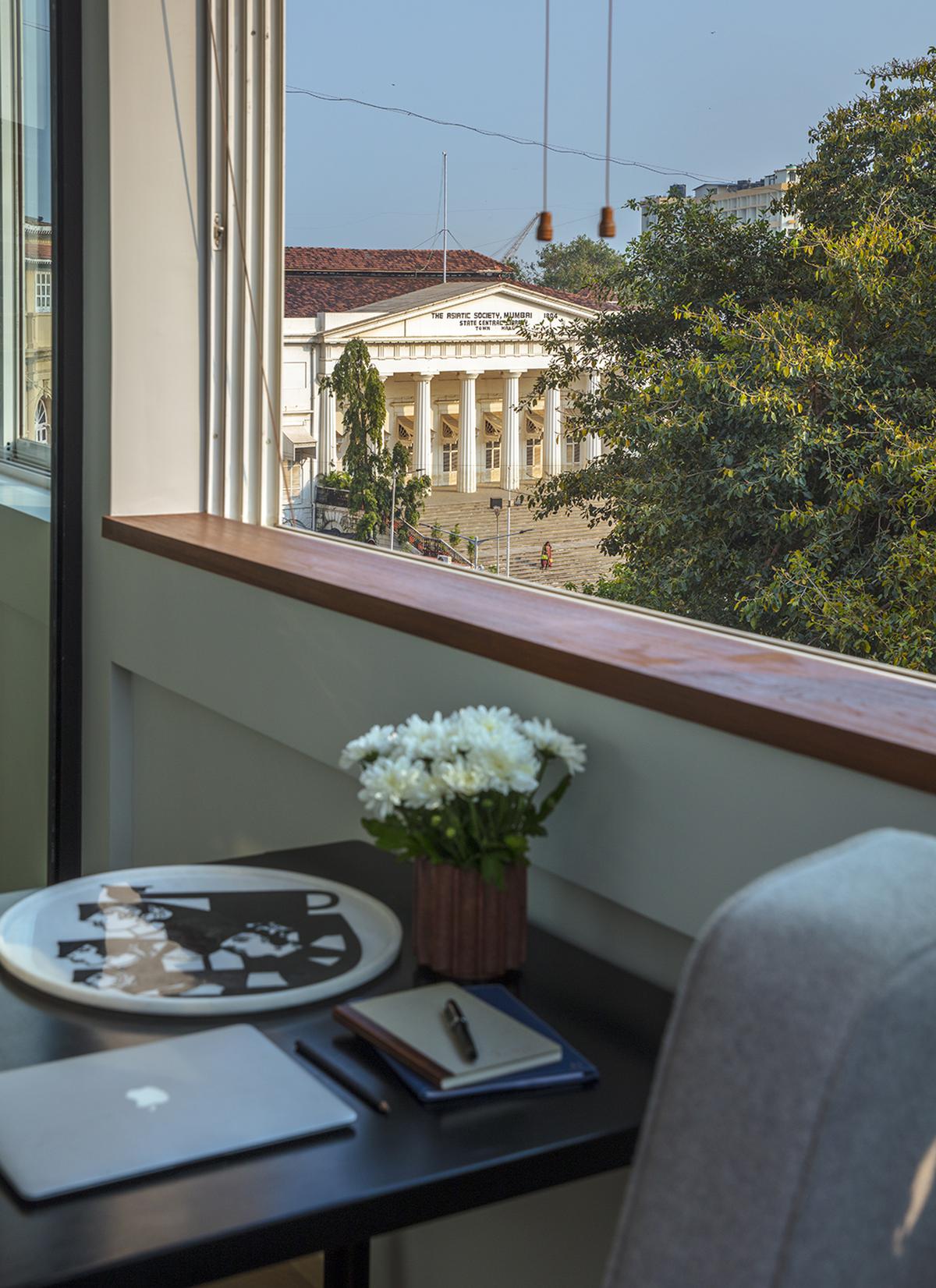
From Rooshad Shroff’s collection
| Photo Credit: Special Arrangement
He explains how the exploration of each craft leads the team to further possibilities and experiments with the artisans. “It’s an interactive process, and not as forthright as conceptualising a piece and then getting it made”. We’ve had our fair share of challenges when it comes to pushing the boundaries of most crafts, adds Rooshad. The mirrors from the Crack range (₹1,75,000 + tax) were “particularly frustrating”. “Each 3-inch piece is segmented with a cracked edge running through, the other side filled in with embroidered recycled Burma teak wood. I have lost count of how many mirrors broke all the way through during the sampling stage!”
Pine needle weaving @ Mangrove Collective, Faridabad
Drawing from the centuries-old pine needle weaving of the indigenous people of Chamba district in Uttarakhand, the label’s Kangra nested table (₹90,000) required several design interventions. “Pine needles have been limited to creating baskets, bangles, and other ornamental pieces, and turning this delicate craft into a durable product by enhancing the structural integrity of the coils required deft weaving skills,” says Suman Sharma, founder and design principal. The tabletop weave is reinforced by adding internal supports and is secured with a coiled stitch. The simplicity of the design, she says, enables the tactile quality of the craft to shine through.
The Shibori Console and Shelving Unit
| Photo Credit: Special Arrangement
Other creations that rely heavily on Indian craft techniques include the shibori console (upwards of ₹2 lakh) and kashundi sofa (starting at ₹1.5 lakh). The console, with brass legs and an oakwood body, uses vibrant indigo shibori hues on its fascia, finished on cotton fabric with the help of varied dyeing methods like bind, fold or twist. The Kashundi Sofa, explains Suman, blends cane weaving and timber in lively mustard hues.
Handwoven bamboo @ Bamboo Pecker, Bengaluru
Recent launches at Suman Roddam’s studio include handbags and baskets made of kouna (water reed), a perennial aquatic herb abundantly cultivated in Manipur. Suman, director at the firm supports an artisan cluster in Thoubal region and says the new offerings “are a result of efforts to reorient kouna crafts to be more acceptable, utilitarian and trendy in urban markets”.
Ask the engineer-turned-designer about his particularly intricate cabinets (starting at ₹22,000), and he explains how they have been designed in order to be developed entirely by hand, including the nails and pegs. “The ply used in the cabinetry is made of handwoven bamboo mats by the artisans of Angamaly, Kerala; the bamboo framework is developed by the artisans of Tripura; cane and bamboo facade mats are woven by the artisans of West Bengal; whereas the brass components by the artisans of Moradabad.”
A cabinet by Bamboo Pecker
| Photo Credit: Special Arrangement
At Bamboopecker, Suman says, designers travel to the artisan cluster to design and prototype. “We do not believe in designing remotely.” What takes longer, he says, “is the time to make them once they are introduced to the market. While we know they are on a schedule, they have a tough time understanding the timelines.” Which is why the team is constantly working on indigenously developed technology that can help in processing of the material used in crafts. “Technology in processing will help in reducing the timelines and costs while still maintaining the uniqueness of a handmade product.” But, he is quick to add that consumer attitudes are shifting. “Clients are more conscious with the choices they are making, and look for something unique. They are aware and do their research on what they are buying, most customers inquire about the process — if it’s toxic-free and sustainable, for example.”
Upcoming collections include a range of cabinets, high tables, collapsible and expandable tables, baby cradles that turn into seaters at end of life, seagrass lamp shades, among others.
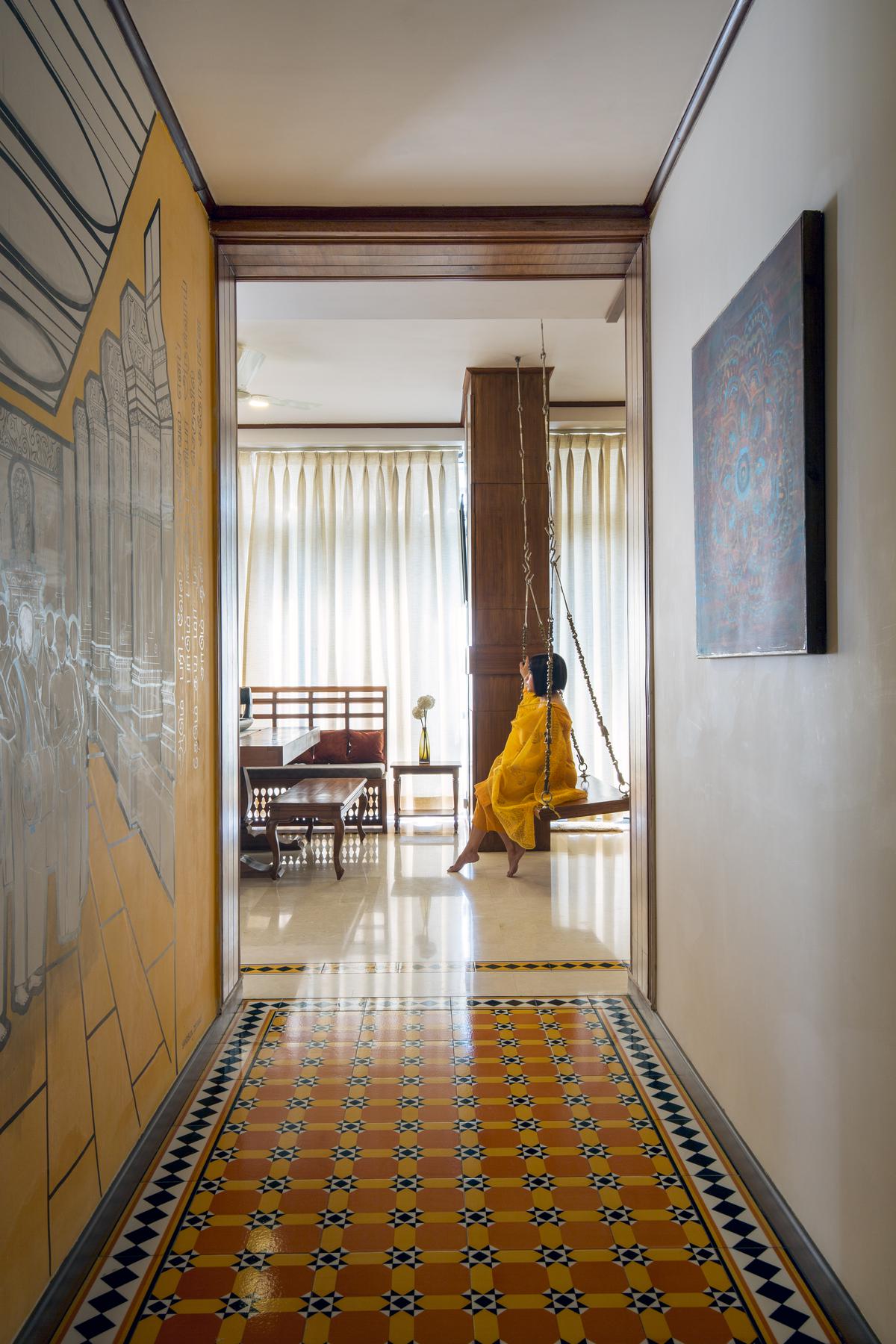
A snapshot of the Delhi residence
| Photo Credit: Special Arrangement
Athangudi tiles @ Envisage, Gurugram
A ‘nalukettu-style’ planned home with vibrant Athangudi tiles gracing the living room — for a South Indian family in New Delhi — is one of the firm’s highlights. “It is typically characterised by a rectangular structure comprising four blocks connected via an open courtyard. It takes traditional designs, elements and textures from South-Indian architecture and augments them into a modern residence,” says Meena Murthy Kakkar, Design Head and Partner.
While Meena appreciates the revival of heritage elements in decor which “can be largely attributed to the pandemic-induced lockdown”, she admits the challenges that came with choosing the Athangudi tiles. The most prominent one being dealing with the breakage in transit. “The overall wastage is more than what happens in installing standard tiles. Also, sometimes it becomes a little tough to get the exact colours, so if the tile shade is different from the rest, the lot must be exchanged with a new one,” she says, adding that communication becomes tough as the artisans work out of their village.
Now working on a “partition between two spaces” at an upcoming Bengaluru residence, Meena explains how the partition consists of a sturdy wooden frame with Channapatna rattles and tops in between. “Coloured using natural vegetable dyes, these vibrant eco-friendly and child-friendly toys are native to the Ramanagara district.”


